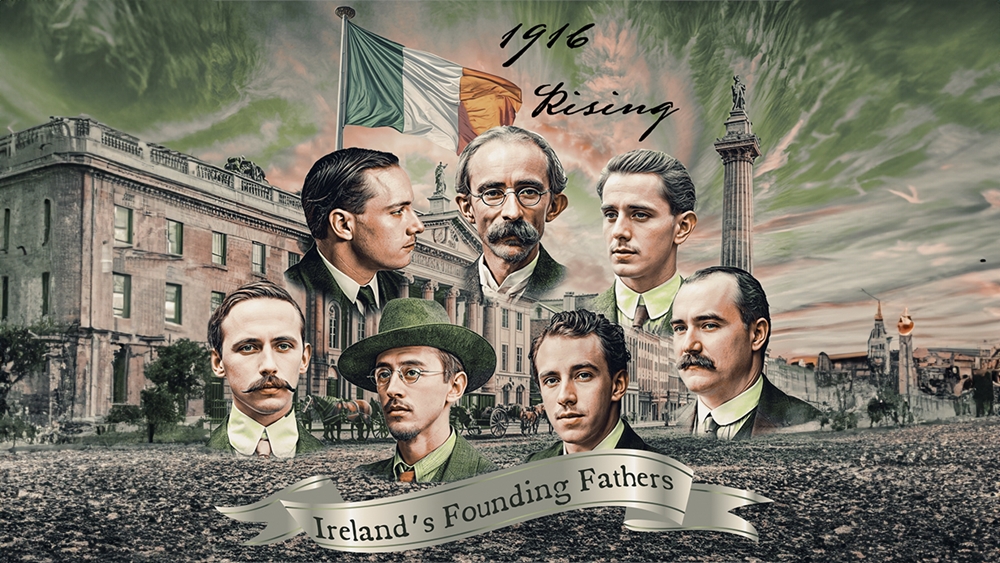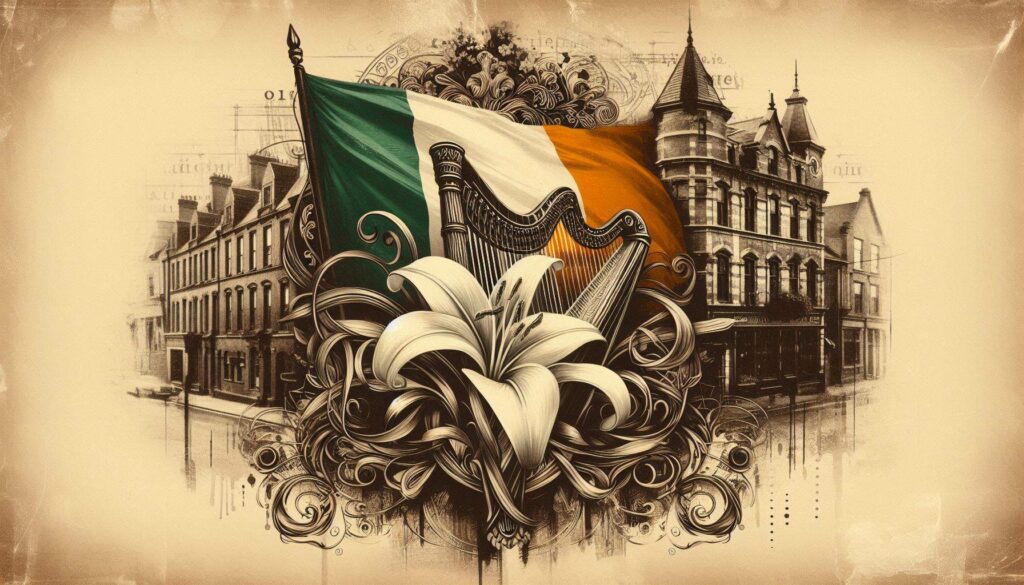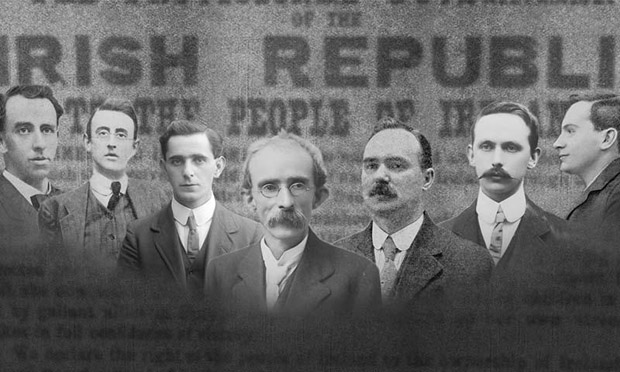How the IRB changed Ireland
Iconic images define key moments in history such as DaVinci’s Last Supper. The iconic image of the seven signatories of the 1916 proclamation portrays the Irish Republican Brotherhoods defining role in Irish history.
The Irish Republican Brotherhood was founded in 1858 with the aim of establishing an independent democratic Irish republic. Following the failed 1848 rebellion and the arrest of many of its leaders James Stephens and John O’Mahony moved to Paris to avoid arrest. While supporting themselves there with teaching and translation work they planned to continue “the fight to overthrow British rule in Ireland”.
Three Tasks in Paris
During his seven years exiled in Paris Stephens set himself three tasks. They were,
- to keep Irelands struggle alive, 7
- to educate themselves with revolutionary knowledge, and
- to master the techniques of conspiracy.
Paris was then a hotbed of secret political societies. By joining one of the most powerful of these and learning the techniques of the “most profound masters of revolutionary science” of the time they learned the means of recruiting and combining people for the purposes of successful revolution. Thus the ideals of what was to become the IRB came into being.
Its principles were that the Irish people had the incontrovertible right to self-determination and national independence. The IRB nurtured and promoted the idea of equality and democracy for all.
Furious Democrats
Its founders unequivocally believed in republicanism defined by them as the “common people are the rightful rulers of their own destiny.” They identified themselves as “furious democrats in theory” and declared the movement to be “wholly and unequivocally democratic.” In the 19th century this was revolutionary and the IRB was denounced by the British establishment, the press, the Catholic Church and the Irish political elite like all Irish Republican and separatist movements.
Despite this the IRB flourished and became Ireland’s first mass democratic movements and one of the world’s leading democratic revolutionary movements. Between the 1879-81 land war and the 1st World War outbreak the IRB was a crucial player in the evolution and growth of modern Irish republicanism. It played a formative role in nurturing popular politicization in Ireland along republican lines.
Irish People Newspaper
In 1863 James Stephens decided a newspaper was necessary to inform, educate and provide a balance against the hostile establishment press. With financial aid from John O’Mahony and the Fenian Brotherhood in America the Irish People was set up. Its offices were at 12 Parliament Street just across from Dublin Castle. The Irish People’s first edition appeared on 28 November 1863. John O’Leary returned from London as editor with Charles Kickham, T C Luby and Denis Dowling Mulcahy as the editorial staff. O’Donovan Rossa and James O’Connor ran the papers business and the printer was John Haltigan. Stephens then departed on an American promotional and fund raising tour. Like the leaders of 1916 as well as being republicans those founding fathers of the IRB were the literary cream of Irish society.
The IRB continued to play a defining role in Irish history and relentlessly campaigned, organised, plotted and planned for Ireland’s independence from the United Kingdom and the establishment of an Irish Republic.
As part of the New Departure of the 1870’s–80’s, the IRB worked relentlessly to influence and democratise the Home Rule League which grew into the Irish Parliamentary Party. It was also involved in the Land War.
Twentieth century
As the 20th century dawned, the IRB was in decline. A new generation of Ulster Republicans set about changing this. In 1905 Denis McCullough and Bulmer Hobson founded the Dungannon Clubs and encouraged enlistment into the IRB rather than the British Army, with the goal of forming an Irish Republic. In 1908 Sean MacDiarmada and Hobson moved to Dublin and teamed with Tom Clarke. Clarke had served fifteen and a half years in Portland Prison and had recently returned from living in the United States to reorganise the IRB.
In 1909 a young Michael Collins was invited to join Sam Maguire. By 1914 the Supreme Council was reinvigorated by idealistic young men such as Hobson, McCullough, Patrick McCartan, John MacBride, Sean MacDiarmada, and Tom Clarke. The latter two were to become the primary instigators of the 1916 Easter Rising.
The IRB’s most glorious achievement was its decisive move in planning and staging the 1916 Easter Rising. Its leader’s execution changed Irish political opinion and landscape as expressed in the 1918 general election that led to the establishment of the first Dáil Éireann in 1919.
The British reacted by suppressing Dáil Éireann and Irish democracy. This fanned the flames of the Irish War of Independence that led to the ‘Anglo-Irish Treaty’ and the establishment of a British Dominion 26 county Irish Free State.
The apartheid 6 county statelet of Northern Ireland had already been pre-emptively created by the British thus dividing the country as it remains today. Finally a British backed Free State counter revolution euphemistically called the Irish Civil War led to the suppression of Republican armed opposition and completed the arrangement to achieve what the British couldn’t.
During those tragic events the IRB like all segments of Irish Society was divided and took no active part in them. Reports of the IRB demise in 1924 consists of Free State propaganda. What did take place was that those in the Republican side of the conflict took on a ‘wait and see’ role while those on the Free State side who still claimed to be members of the IRB but could not be, as they were in violation of its oath and constitution. Their breach of the IRB oath to defend the Republic automatically excluded them. They ignominiously dissolved their claim to IRB membership in 1924 claiming that was its demise.
The remaining members of the IRB adhering to their oath continued to hold irregular meetings and laid wreaths at commemorative events. It struggled on in that manner until recent times neither making any comments on nor playing any role in the 1950’s Border Campaign nor in the 30 years’ war in Northern Ireland. It reduced itself to laying wreaths and writing letters to 26 county politicians whom its constitution does not even recognise. It was time for a revival.
In 2011 with the centenary of 1916 fast approaching the IRB at its AGM in Hayes Hotel, Thurles appointed new members of the Executive and plans were put in place to reinvigorate the organisation. However this was a false dawn as the old guard simply ignored them and continued as if they didn’t exist.
This situation simmered until 2018 with all sorts of disruptive nonsense from the non elected controlling clique when the branches unanimously voted no confidence in this splinter of the old guard. In a set of pique at this together with the outgoing president Billy McGuire, they attempted a coup by demanding the standing down of the elected officers, members and branches and the disbandanment of the whole organisation. They were ignored as they had no standing or authority to do this.
The Executive then called the 2019 AGM as required by the constitution. The old guard and the outgoing President were invited but they failed to attend. The well attended AGM took place and a new Executive and a new President were elected. Since then new IRB branches have and are being formed. An updated set of amendments to the constitution is being finalised. A new Charter setting out who we are and what we represent has been drawn up and new initiatives are taking place to deal with the country’s sorry state.
Plans are being developed to deal with the banking crisis, wholesale evictions not seen since the 19th Century, an unprecedented housing crisis and migrants being housed ahead of Irish people waiting for years to be housed, The Gardaí are behaving more like the Mafia. The politicians are acting only in their own interest and are stuffing their wallets with your money. The out of control judiciary are totally ignoring the law as they do the bidding of the banks and vulture funds.
The IRB today
The Irish Republican Brotherhood is based upon the fundamental principles of the Irish people’s right to sovereignty, democracy and national integrity. A strong and vigorous IRB is needed now as much as ever before because only a united people can put things right.
The IRB is the oldest, and has been the leading and most influential Irish republican organisation at crucial times in our history and is well served to act as an umbrella or parent organisation for all members of our diverse republican family in this time of crisis.
They are invited to affiliate as equals within the IRB umbrella without compromising their position where they can together debate their validly held positions with their consensus aims of achieving their common objective. Both you and your Republican organisation are invited to join the IRB or join with the IRB now.
A defining moment
Iconic images define key moments in history such as DaVinci’s Last Supper. The iconic image of the seven signatories of the 1916 proclamation defines the Irish Republican Brotherhoods role in Irish history. Attempts to describe them as fanatics and terrorists by revisionists cannot be upheld. Without question they were intellectual cream of Irish society. No more illustrious or diverse a collection of Irish men have come together before or since.
From Joseph Plunkett scion of a land owning titled family with roots going back to the Vikings to James Connolly born of Irish working class parents in Edinburgh they were all great thinkers, visionaries, poets and writers. They had one common goal, the vision of a free and Gaelic Ireland that they ultimately gave their lives for.
They came together under the inspiration and invitation of Tom Clarke and Sean MacDiarmada while reorganising the IRB and they quickly percolated to the top as its cream, and as the saying goes ‘the rest is history’.
It was no coincidence that such illustrious IRB men should lead the 1916 Rising. From its inception in 1858 the IRB has always attracted noble and illustrious figures and visionaries into its ranks and it continues to do so. Their role is your role now.
Related Posts
As we celebrate this season of renewal and hope on the IRBs 109th anniversary of 1916 we extend our warmest Easter greetings to all our members and […]
The Irish Republican Brotherhood together with the Fenians was founded simultaneously in Ireland and the United States. It is the oldest political movement in Ireland. Since its foundation in […]
The IRB or the Fenians as they were commonly known are among the famous but also the most misunderstood organisations of modern Irish history. The common 19th […]




